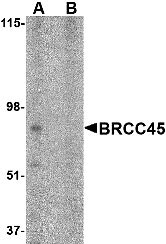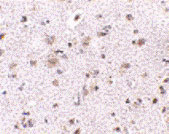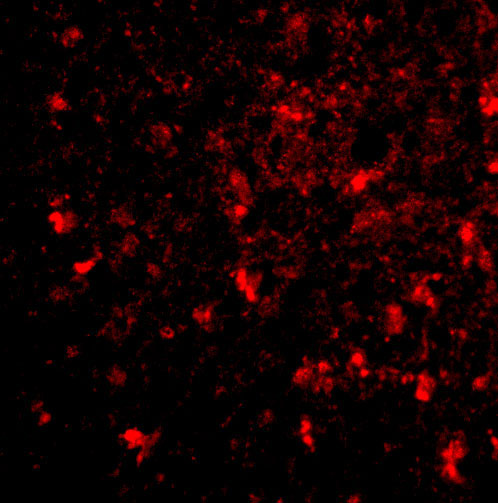BRCC45 Antibody
- 产品详情
- 实验流程
- 背景知识
Application
| WB, IF, E, IHC-P |
|---|---|
| Primary Accession | Q9NXR7 |
| Other Accession | NP_004890, 21361171 |
| Reactivity | Human, Mouse, Rat |
| Host | Rabbit |
| Clonality | Polyclonal |
| Isotype | IgG |
| Calculated MW | 43552 Da |
| Concentration (mg/ml) | 1 mg/mL |
| Conjugate | Unconjugated |
| Application Notes | BRCC45 antibody can be used for detection of BRCC45 by Western blot at 1 µg/mL. Antibody can also be used for immunohistochemistry starting at 2.5 µg/mL. For immunofluorescence start at 20 µg/mL. |
| Gene ID | 9577 |
|---|---|
| Other Names | BRCA1-A complex subunit BRE, BRCA1/BRCA2-containing complex subunit 45, Brain and reproductive organ-expressed protein, BRE (HGNC:1106), BRCC45 |
| Target/Specificity | BRE; |
| Reconstitution & Storage | BRCC45 antibody can be stored at 4℃ for three months and -20℃, stable for up to one year. As with all antibodies care should be taken to avoid repeated freeze thaw cycles. Antibodies should not be exposed to prolonged high temperatures. |
| Precautions | BRCC45 Antibody is for research use only and not for use in diagnostic or therapeutic procedures. |
| Name | BABAM2 (HGNC:1106) |
|---|---|
| Synonyms | BRCC45, BRE |
| Function | Component of the BRCA1-A complex, a complex that specifically recognizes 'Lys-63'-linked ubiquitinated histones H2A and H2AX at DNA lesions sites, leading to target the BRCA1-BARD1 heterodimer to sites of DNA damage at double-strand breaks (DSBs). The BRCA1-A complex also possesses deubiquitinase activity that specifically removes 'Lys-63'- linked ubiquitin on histones H2A and H2AX (PubMed:17525341, PubMed:19261746, PubMed:19261748, PubMed:19261749). In the BRCA1-A complex, it acts as an adapter that bridges the interaction between BABAM1/NBA1 and the rest of the complex, thereby being required for the complex integrity and modulating the E3 ubiquitin ligase activity of the BRCA1-BARD1 heterodimer (PubMed:19261748, PubMed:21282113). Component of the BRISC complex, a multiprotein complex that specifically cleaves 'Lys-63'-linked ubiquitin in various substrates (PubMed:19214193, PubMed:24075985, PubMed:25283148, PubMed:26195665). Within the BRISC complex, acts as an adapter that bridges the interaction between BABAM1/NBA1 and the rest of the complex, thereby being required for the complex integrity (PubMed:21282113). The BRISC complex is required for normal mitotic spindle assembly and microtubule attachment to kinetochores via its role in deubiquitinating NUMA1 (PubMed:26195665). The BRISC complex plays a role in interferon signaling via its role in the deubiquitination of the interferon receptor IFNAR1; deubiquitination increases IFNAR1 activity by enhancing its stability and cell surface expression (PubMed:24075985). Down-regulates the response to bacterial lipopolysaccharide (LPS) via its role in IFNAR1 deubiquitination (PubMed:24075985). May play a role in homeostasis or cellular differentiation in cells of neural, epithelial and germline origins. May also act as a death receptor- associated anti-apoptotic protein, which inhibits the mitochondrial apoptotic pathway. May regulate TNF-alpha signaling through its interactions with TNFRSF1A; however these effects may be indirect (PubMed:15465831). |
| Cellular Location | Cytoplasm. Nucleus Note=Localizes at sites of DNA damage at double-strand breaks (DSBs) |
| Tissue Location | Expressed in all cell lines examined. Highly expressed in placenta. |
For Research Use Only. Not For Use In Diagnostic Procedures.
Provided below are standard protocols that you may find useful for product applications.
BACKGROUND
BRCC45 Antibody: BRCC45 was initially suggested to be a housekeeping protein that is highly expressed in brain and reproductive organs. Later experiments indicated BRCC45 forms a complex with the breast and ovarian predisposition proteins BRCA1 and BRCA2 as well as RAD51 and BRCC36. This complex has a ubiquitin E3 ligase activity and is thought to enhance cellular survival following DNA damage. BRCC45 has also been suggested to function as a death receptor-associated anti-apoptotic protein by inhibiting the BID-induced activation of the mitochondrial apoptotic pathway. Higher levels of BRCC45 were detected in the majority of hepatocellular carcinomas, suggesting that BRCC45 may promote tumorigenesis when overexpressed. At least three isoforms of BRCC45 are known to exist.
REFERENCES
Li L, Yoo H, Beckker FF, et al. Identification of a brain- and reproductive-organs-specific gene responsive to DNA damage and retinoic expression. Biochim. Biophys. Res. Commun.1995; 206:764-74.
Dong Y, Hakimi MA, Chen X, et al. Regulation of BRCC, a holoenzyme complex containing BRCA1 and BRCA2, by a signalsome-like subunit and its role in DNA repair. Mol. Cell2003; 12:1087-99.
Li Q, Ching AK, Chan BC, et al. A death receptor-associated anti-apoptotic protein, BRE, inhibits mitochondrial apoptotic pathway. J. Biol. Chem.2004; 279:52106-16.
Chan BC, Ching AK, To KF, et al. BRE is an antiapoptotic protein in vivo and overexpressed in human hepatocellular carcinoma. Oncogene2007; epub.
终于等到您。ABCEPTA(百远生物)抗体产品。
点击下方“我要评价 ”按钮提交您的反馈信息,您的反馈和评价是我们最宝贵的财富之一,
我们将在1-3个工作日内处理您的反馈信息。
如有疑问,联系:0512-88856768 tech-china@abcepta.com.























 癌症的基本特征包括细胞增殖、血管生成、迁移、凋亡逃避机制和细胞永生等。找到癌症发生过程中这些通路的关键标记物和对应的抗体用于检测至关重要。
癌症的基本特征包括细胞增殖、血管生成、迁移、凋亡逃避机制和细胞永生等。找到癌症发生过程中这些通路的关键标记物和对应的抗体用于检测至关重要。 为您推荐一个泛素化位点预测神器——泛素化分析工具,可以为您的蛋白的泛素化位点作出预测和评分。
为您推荐一个泛素化位点预测神器——泛素化分析工具,可以为您的蛋白的泛素化位点作出预测和评分。 细胞自噬受体图形绘图工具为你的蛋白的细胞受体结合位点作出预测和评分,识别结合到自噬通路中的蛋白是非常重要的,便于让我们理解自噬在正常生理、病理过程中的作用,如发育、细胞分化、神经退化性疾病、压力条件下、感染和癌症。
细胞自噬受体图形绘图工具为你的蛋白的细胞受体结合位点作出预测和评分,识别结合到自噬通路中的蛋白是非常重要的,便于让我们理解自噬在正常生理、病理过程中的作用,如发育、细胞分化、神经退化性疾病、压力条件下、感染和癌症。








